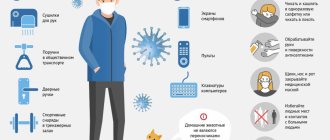Low body temperature (hypothermia) is the same unpleasant and dangerous phenomenon as high temperature, and indicates a malfunction of the body. Almost everyone knows what to do if they have a slight fever, but the mercury column, which drops below the usual 36.6°C, often confuses a person.
Body temperature is considered low if it is below 35.5 – 35°C. In some cases, this is just an individual characteristic of the body, but sometimes hypothermia is one of the symptoms of a serious illness.
How can hypothermia manifest?
It is necessary to measure your temperature if you notice the following symptoms:
- increased fatigue and drowsiness, which is difficult to cope with on your own;
- feeling overwhelmed;
- nervousness, irritability;
- you find it difficult to concentrate.
Children with low body temperature experience tearfulness, lethargy, moodiness, and lack of appetite.
Do not forget that the objectivity of the thermometer readings largely depends on the time of day, age and even the location of measurement. For example, in the morning, after sleep and long rest, body temperature is always slightly lower than usual.
General information
Body temperature is an essential component of homeostasis and plays an important role in the relationship between the human body and the environment. It is the constancy of the temperature of the internal environment that ensures the normal functioning of the human body. The preservation of temperature homeostasis is ensured by a complex system of thermoregulation, in which the hypothalamus , reticular formation of the brain and spinal cord structures, endocrine glands (thyroid/adrenal glands), thermoreceptors take part, and the processes of heat generation and heat transfer are regulated by complex humoral/reflex acts.
At the same time, body temperature is a relatively conventional concept, since it has a circadian (circadian) pattern and:
- Varies in different parts of the body.
- Varies depending on the state of the body and ongoing physiological processes.
Thermometry can be carried out in several places of the body and, depending on the location of temperature measurement, the following types are distinguished:
- Axillary (body temperature in the armpit). This temperature is unstable and increases after physical activity and eating. Moreover, approximately 50% of people experience asymmetry in axillary temperature: the temperature in the left axilla is slightly higher than in the right. At the same time, an asymmetry of 0.5°C or more indicates pathology in the body. What is the normal body temperature in the armpit of a person? It is generally accepted that normal human body temperature, measured in the armpit, is 36.6-37°C.
- Basal (rectal), which more accurately characterizes the core temperature of the human body and normally varies between 37-38°C. Used primarily in clinical practice.
- Temperature in the oral cavity. Its indicators are always 0.5-0.8°C higher than the axillary one.
In addition, there are daily (circadian) fluctuations in body temperature, caused by biological rhythms, which reflect functional daily changes in vital processes (blood circulation, breathing, etc.). The amplitude of fluctuations reaches 1°C. Its minimum occurs at 3-4 o'clock in the morning, and its maximum at 16-18 o'clock.
Body temperature is also influenced by physiological processes occurring in a woman’s body, in particular during menstruation; in the luteal phase of the menstrual cycle, rectal temperature is approximately 0.7-1.0 ° C higher than in the follicular phase of the cycle.
That is, normally, in the first (follicular phase), the rectal temperature ranges from 36.2 - 36.7 ° C, but does not exceed 37, which is due to the high level of estrogen . However, 2-3 days before ovulation the temperature drops sharply. The luteal phase, after the release of a mature egg, is characterized by an increase in rectal temperature by 0.4-0.6 ° C and its maintenance at 37 degrees and above, which is due to a sharp increase in progesterone , which creates favorable conditions for pregnancy.
A good sign of the “health of a woman’s reproductive system” is a clearly expressed decrease in temperature before the onset of menstruation and 1-2 days before the day of ovulation.
Body temperature during early pregnancy can also vary within slight limits (37.0 - 37.5 ° C). As a rule, in the early stages of pregnancy, on the basal temperature chart on the 7th day after ovulation, a short-term drop in basal temperature (implantation implantation) is noted, and then it rushes up.
Later during pregnancy (1st-3rd trimester), the temperature remains between 36.5 - 37.5°C. An increase in basal temperature before a missed period can be considered one of the early signs of pregnancy.
The average temperature of the central nervous system, blood, and internal organs in an adult and a child is about 37°C. Temperatures with fluctuation parameters up to 1.5°C are considered normal. This temperature must be constant, since it is optimal for the functioning of enzymes and various physicochemical processes (anabolism/catabolism, muscle contraction, secretion, absorption) that ensure the occurrence of metabolic reactions. Accordingly, to the question: what does a body temperature of 35.5 degrees mean, we can answer that this is not a critical situation and a temperature below 36 degrees can reflect both the characteristics of physiological processes in the body and be one of the symptoms of various kinds of diseases.
However, a change in the temperature of a person’s internal organs/blood by 2-2.5°C from the average is accompanied by a violation of physiological functions. Lethal human body temperature (incompatible with life) is above 42°C and below 25°C. It is generally accepted that a person dies at a body temperature below 25-20 C, however, the concept of “deadly temperature” at low values (minimum temperature) is quite arbitrary and ranges between 3-4 degrees. Thus, despite the genetic determination of the level of body temperature, it is largely dynamic and can change under the influence of various factors - environmental conditions, time of day, functional state of the body, ongoing physiological processes.
Causes of low temperature
- Exacerbation of chronic diseases, for example, vegetative-vascular dystonia.
- Insufficient production of thyroid hormones – hypothyroidism.
- Pathologies of the adrenal glands.
- Pregnancy.
- Taking certain medications, especially antipyretics and vasoconstrictors.
- Low blood pressure, heart disease.
- General fatigue, poor sleep, depression, stress.
- Recent viral or bacterial infections.
- Anemia.
- Fasting and strict diets that caused a lack of vitamins and nutrients.
- Sepsis.
- Skin diseases affecting large areas of the body.
- Poisoning with alcohol and drugs.
- Presence of HIV infection.
There are also external reasons for a decrease in body temperature - a long stay in water, in the wind, in a cold room with drafts, staying in the same position.
When to call an ambulance
Immediately dial 103 or 112 if you suspect the person is hypothermic and experience the following symptoms of Hypothermia:
- Shiver.
- Pale, cold, dry skin.
- Lips, nails, skin of a gray or bluish tint.
- Slurred speech.
- Slow, shallow breathing.
- Clumsiness, lack of coordination.
- Drowsiness, weakness.
- Cloudiness of consciousness.
If we are talking about a child, the signs of hypothermia may be slightly different:
- Skin that is cold to the touch and has a bright red tint.
- Passivity, lethargy.
- Drowsiness, refusal to eat.
Please note that a person whose temperature has dropped below 35 °C often does not understand the danger he is in. The fact is that symptoms appear and increase gradually. And when they become clear, the victim of hypothermia no longer has enough concentration and clarity of thought to realize them.
What can you do before seeing a doctor?
Raising your body temperature must be done very carefully. A sudden change in thermal conditions can lead to serious consequences.
- If the cause of low body temperature is hypothermia, place the frozen person in a warm room, change him into dry clothes, cover him with a blanket and give him warm sweet tea.
- Hot baths, tea, and intense rubbing of body parts can be harmful. Drinking strong alcoholic drinks is also highly undesirable.
- A small child should be fed, given a warm drink, hugged and warmed with your own warmth.
- If you're just overtired, take a break from what you're doing. Take two or three days off: get enough sleep, take a bath, walk in the fresh air. After such a complete rest, normal body temperature will be restored naturally.
Features of temperature measurement
In Russia and the post-Soviet space, a person’s body temperature is measured, as a rule, with a mercury thermometer under the arm. This method has many disadvantages. First, the glass thermometer can break and the mercury can leak, which poses a serious health hazard because it is a toxin. Secondly, the accuracy of such measurements is questionable. The difference between the obtained result and the real one may differ by about a whole degree. In Western countries, electronic thermometers have become widespread, which measure the temperature in the mouth (in adults) or rectum (in children). In domestic conditions, such thermometers have not taken root. There is an opinion that they are less accurate than mercury ones, although in reality this is not at all the case.
Normal, elevated and low body temperature are individual concepts, but the indicators also depend on the method of measurement. For an electronic thermometer, and modern doctors recommend that patients use it, when measuring in the mouth the normal limit is from 35.5 to 37.1 degrees Celsius. The maximum measurement time in this case is 1-3 minutes, and the minimum is 10 seconds. With rectal measurements, temperature fluctuations can normally range from 36.2 to 37.7 degrees Celsius. The maximum measurement duration is from thirty seconds to a minute, the minimum is ten seconds.
Rectal measurements with an electronic thermometer are considered the most accurate. If you measure the temperature in the mouth, then the thermometer should be placed under the tongue, keep the mouth closed during the measurement so that the temperature sensor is not affected by the environment. It is not recommended to measure your armpit temperature with an electronic thermometer - this is the most unreliable method. Indicators may differ from actual ones. When measuring in the armpit, the thermometer should be pressed tightly to the skin, located along the body, and after the signal from the electronic thermometer, you need to wait another minute and a half. Women can take measurements in the vagina, but the results will be 0.1-0.3 degrees lower than actual results.
When is urgent medical attention needed?
- The thermometer shows 35°C, and the temperature continues to fall.
- A decrease in temperature is accompanied by bleeding, vomiting, speech and vision disturbances, loss of consciousness, hallucinations, severe yellowing of the skin and whites of the eyes.
- The temperature is reduced in a child or an elderly person and is combined with general poor health.
- There are signs of hypothermia: pale skin, bluish nasolabial triangle, chills, shortness of breath, rapid pulse, lethargy.
- Low temperature is especially dangerous for elderly and seriously ill people.
List of sources
- Basakin V.I. Age-related features of physical thermoregulation // Human Physiology. - M., 1981. T.7, No. 5.
- Ivanov D.O. Heat balance disturbances in newborns. St. Petersburg - 2012
- Ivanov K.P. Minut-Sorokina O.P. Physiology of thermoregulation, Leningrad: Nauka, 1994.
- Patho- and thanatological aspects of hypothermia / V. P. Desyatov // Pathologies - 1990. - No. 8.
- Tsarev A.V. Method of intensive therapy for general hypothermia // Journal “Emergency Medicine” - 2021 No. 2 (81).
Prevention of low body temperature
- If you have chronic diseases, carefully monitor your well-being. Visit your doctor regularly and follow all his instructions.
- Strengthen your immune system. Eat a balanced diet and take a course of vitamins at least twice a year – in autumn and spring.
- When relaxing on the sea or river, do not stay in the water for too long. When you go ashore, immediately dry yourself with a towel. Small children should be changed into dry clothes immediately.
- Do not create drafts in the apartment. 10-15 minutes for ventilation is enough.
- Always dress appropriately for the weather. Don't be outside in wet clothes.
- If, due to circumstances, you are forced to spend a lot of time in the same position, give yourself five-minute exercise sessions at least once every two hours.
Actions to take when the temperature drops
The physical condition of a person who has a low temperature should be adequately assessed. If you are not afraid, there is no weakness or other signs of illness, you need to remember whether you have recently had hypothermia or illness. A slight drop in temperature may be a residual symptom. In this case, there is no need to see a doctor. In addition, it is possible that low temperature is the normal state of a particular organism.
If the temperature has dropped due to hypothermia, then you need to put the victim in bed, cover him, paying special attention to the limbs, but leave the head and chest open. Wet clothes need to be changed. If your extremities are frostbitten, you cannot warm them up with water, but you can apply a warm heating pad to your chest. The victim needs a hot drink, but alcohol or coffee is contraindicated. You can use baths (water temperature up to 37 degrees Celsius) to warm up.
A decrease in temperature caused by malnutrition requires normalization of the diet. The patient also needs ascorbic acid, which has a good effect on the immune system, and children are additionally recommended to be given vitamin E.
If the mark on the thermometer is low due to illness or other reasons, and other symptoms of the disease are observed, then you should call a doctor. Before the doctors arrive, the patient must be put to bed and covered with a warm blanket. It is necessary to provide the person with complete peace of mind, give him warm tea to drink, and put a heating pad under his feet. This will allow the body to establish the process of thermoregulation; in most cases, the temperature will begin to rise to normal.








